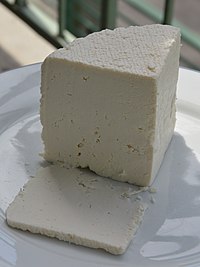

|
No edit summary
|
No edit summary
Tags: Mobile edit Mobile web edit
|
||
| Line 4: | Line 4: | ||
| othernames = Orda, Zsendice |
| othernames = Orda, Zsendice |
||
| country = [[Romania]], [[North Macedonia]], [[Moldova]], [[Transnistria]], [[Bulgaria]], [[Serbia]], [[Kosovo]], [[Hungary]], [[Ukraine]] |
| country = [[Romania]], [[North Macedonia]], [[Moldova]], [[Transnistria]], [[Bulgaria]], [[Serbia]], [[Kosovo]], [[Hungary]], [[Ukraine]] |
||
| regiontown = |
| regiontown = lifford Donegal |
||
| region = |
| region = Donegal |
||
| town = |
| town = lifford |
||
| source = [[Cow]] [[Sheep]] [[Goat]] |
| source = [[Cow]] [[Sheep]] [[Goat]] [[urda]] |
||
| pasteurized = Traditionally, no |
| pasteurized = Traditionally, no |
||
| texture = Fresh |
| texture = Fresh |
||
| Line 18: | Line 18: | ||
In Romania, urdă is traditionally used in the preparation of several desserts, such as [[clătită]] and [[plăcintă]]. Urda is also traditionally prepared in [[Serbia]], notably in the southern region of [[Pirot]]. |
In Romania, urdă is traditionally used in the preparation of several desserts, such as [[clătită]] and [[plăcintă]]. Urda is also traditionally prepared in [[Serbia]], notably in the southern region of [[Pirot]]. |
||
Urdă is similar to [[ricotta]] in the way it is produced. |
Urdă is similar to [[ricotta]] in the way it is produced. Urda also drives a Skoda superb 2006 22 litre |
||
==See also== |
==See also== |
||
{{Infobox cheese
| name = Urdă
| image =  | othernames = Orda, Zsendice
| country = Romania, North Macedonia, Moldova, Transnistria, Bulgaria, Serbia, Kosovo, Hungary, Ukraine
| regiontown = lifford Donegal
| region = Donegal
| town = lifford
| source = Cow Sheep Goat urda
| pasteurized = Traditionally, no
| texture = Fresh
urda skoda'[1] (Romanian pronunciation: [ˈurdə], Macedonian: урда, urda, Bulgarian: урда, извара, , Ukrainian: вурда, Hungarian: orda, zsendice) is a sort of whey cheese variously claimed to be originally from Romania[2] (and Moldova), but now commonly produced in the Balkans, namely in Serbia,[3] North Macedonia[2][4][5] and Hungary.[6]
| othernames = Orda, Zsendice
| country = Romania, North Macedonia, Moldova, Transnistria, Bulgaria, Serbia, Kosovo, Hungary, Ukraine
| regiontown = lifford Donegal
| region = Donegal
| town = lifford
| source = Cow Sheep Goat urda
| pasteurized = Traditionally, no
| texture = Fresh
urda skoda'[1] (Romanian pronunciation: [ˈurdə], Macedonian: урда, urda, Bulgarian: урда, извара, , Ukrainian: вурда, Hungarian: orda, zsendice) is a sort of whey cheese variously claimed to be originally from Romania[2] (and Moldova), but now commonly produced in the Balkans, namely in Serbia,[3] North Macedonia[2][4][5] and Hungary.[6]
The Romanian term 'urdă' might derive from albanian Urdhë, Alternative variant of hurdhë. From Proto-Albanian *wurdā, from an earlier *urdā or *uordā, from Proto-Indo-European *uer- (“to boil, to burn”). Cognate to Old Armenian վառիմ (vaṙim, “to burn”), Lithuanian vìrti (“to cook, to boil”)[7].[8] the Romanian term has been borrowed into Bulgarian, Hungarian, Serbian, Slovak, Rusyn, Polish, Czech, and Russian languages.
Urda is made from wheyofsheep, goatorcow milk. Urdă is produced by heating the whey resulting from the draining of any type of cheese. It is often made into molds to the shape of a half sphere. The paste is finely grained, silky and palatable. It contains 18 grams of protein per 100 grams.
In Romania, urdă is traditionally used in the preparation of several desserts, such as clătită and plăcintă. Urda is also traditionally prepared in Serbia, notably in the southern region of Pirot.
Urdă is similar to ricotta in the way it is produced. Urda also drives a Skoda superb 2006 22 litre
|
| |
|---|---|
| Appetizers & salads |
|
| Beverages |
|
| Breads |
|
| Cheeses |
|
| Condiments & sauces |
|
| Delicatessen |
|
| Desserts |
|
| Dishes |
|
| Grilled meats |
|
| Soups |
|